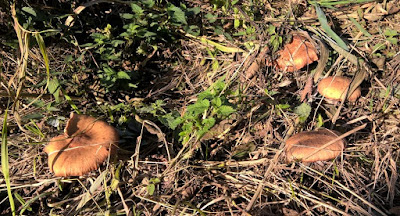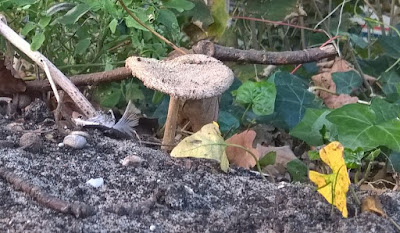One of my little dreams is to make and give a workshop about topology for artists, walkers and outher outsiders. It might be called: The topological toolkit. What you didn't know about spaces. Or maybe: Topology as philosophy of space. These are preliminary notes: YouTube topology, Styles of topology, Spaces and maps, Translation, Words in linguistic space, Workshop contents sketch. I try to post small updates often, to keep myself working on this.
I browsed XKCD for "topology" I found a few discussions about organizing a workshop for beginners. See the list of sources at the end.
Encouragement for making a workshop
I feel encouraged by this statement. And I still don't know if this has anything to do with the author of the XKCD comic (I guess not, but I'm not sure):
Topology is fun to talk about, since people who don't actually study it have never heard any of this.
I'd like to take this opportunity to encourage any and all grad students to organize their own student seminars. The best way to really learn a topic is to give a talk about it, to force yourself to be able to explain it in understandable terms. Also, the best way to become comfortable with speaking is to give lots of talks. There are many things I'd like to improve about my speaking style, but I think it's safe to say that anything good about it is a result of the many talks that I gave in this seminar over the course of my graduate career.
Some items will be difficult to translate into "normal" (non-mathematical) concepts. I indicate this difficulty with 1 to 3 stars.
Start from our normal space *
Skimp the technical stuff for conceptual understanding. You can't teach topology in an hour, but you can get the students interested in it in that time frame.
Start with a concrete example. We don't need to talk about the general case of a topological space, and it would be pointless to try to do so in an hour-long presentation. One- and two-dimensional space is something everyone is familiar with, so take advantage of that. The entire concept of open and closed sets comes directly from observations in the metrics on R and R^2.
Experiment with spaces *
The intro I like to talk about is gluing together edges of a square in order to make a sphere (all glued into a single point), a torus (opposite sides glued), a Klein bottle (one pair of opposite sides glued with a flip), and real projective space (both opposite sides glued with flips).
What do a sphere, a torus, and a Klein bottle all have in common (but a plane doesn't)?
Open and closed sets *
I think it might be good to show using simple, concrete examples. First, explain what open and closed sets are, in nontechnical terms, and give examples:
- An open set is a set where every point can be wiggled a little bit and still be inside the set
- A closed set is a set whose complement is open
- Examples of open sets in R include (0, 1), (-pi, pi), and (0, infinity)
- Examples of closed sets in R include [0, 1], [0, 42], [-10, 10]
- Open and closed are NOT opposites. The interval (0, 1] is an example of a set which is NEITHER open NOR closed. The empty set and the set R itself are BOTH open AND closed.
A topology is a set along with a collection of open subsets of that set. A topology completely specifies the topological properties of its underlying space. The underlying space is just a convenient metaphor; it is not actually necessary.
The topology doesn't just 'determine' the open sets; it 'is' the open sets. A topology on a set is just a collection of subsets that is closed under arbitrary unions and finite intersections, and which contains the empty set and the whole set. It has no more structure than this. Every topological concept must be definable *entirely* in terms of basic set/logical operations and whether or not certain sets are members of the topology, or it can't be purely topological.
A topology on a set is just a sort of rule telling us which points are 'close together'. It does this by specifying something called a closure operation: the closure of a set A is the set of all the points 'close' to A. Since the idea of topology is to study this idea in general, though, we'll let any operation count as a closure operation, and just redefine 'close' to match, as long as it satisfies a few basic rules: (list the Kuratowski closure axioms).
The hard thing to get used to about topological spaces is just how little structure is imposed by the axioms. For instance, the topology arising from an arbitrary metric space is already much more special and well-behaved than an arbitrary topology.
Neighborhoods *
Go on to explain these concepts generalize into R^2 naturally.
A circle including all points inside and including the boundary is an example of a closed set. A circle including all its interior points, but without the boundary is an example of an open set.
An open set containing a point p is called an (open) neighborhood of p.
Metric spaces and distances ***
If you're talking about distances, you're in a metric space. In what's called a metric space, for example, an open set is one where every point inside has a small region around it that's still inside the set.
Closed versus bounded *
Closed and bounded are unrelated, in the sense that we can find examples of subsets of topological spaces for every combination of {closed, not closed} and {bounded, not bounded}. In fact, we can find subsets of all four types just within the real line:
- [0,1] as a subset of the real line is closed and bounded, and its complement (-infinity,0) U (1,infinity) is neither closed nor bounded.
- (0,1) as a subset of the real line is bounded but not closed, and its complement (-infinity,0] U [1,infinity) is closed but not bounded.
Then, it is nice to produce a useful result with the definitions. The topological definition of a function is a really good example.
A function f maps points from R^2 to R^2. We can also think of f mapping subsets of R^2 to subsets of R^2 in a natural way: If X is a set, then f(X) is the set {f(x) for x in X}.
Then, finally, a continuous function from R^2 to R^2 is one where the following is possible. Given any open set in R^2 called Y, we can find an open set in R^2 called X such that f(X) is a subset of Y.
The reason for using R^2 is it makes for a nicer picture. Wikipedia has a nice picture of what I mean (though, the names of the variables are different): en.wikipedia.org/wiki/Continuous_function
Pathologies ***
Finally, some pathology: you could display the multitude of limits of a sequence in a non-T2 space etc. If you really want to, you can talk intuitively about the long line (although I doubt there's anything intuitive about it ).
If your audience is at a high enough level, it might be fun to show some "strange" examples. Define a homeomorphism and talk about why we require a continuous inverse to a continuous mapping (ask them for an example; if they've only ever seen real functions of a real variable, they'll have to think about it), show them some homeomorphic spaces (specifically do the stereographic projection of a sphere onto a plane), maybe show some manifolds (they look nice; it might be worth it to mention fundamental polygons here, at least for the torus and the Möbius strip, perhaps the projective plane).
Further study ***
https://en.wikipedia.org/wiki/Space_(mathematics)
Sources
https://etale.site/xkcd/
http://forums.xkcd.com/viewtopic.php?t=29671
http://forums.xkcd.com/viewtopic.php?t=37039
http://fora.xkcd.com/viewtopic.php?t=66742
http://forums.xkcd.com/viewtopic.php?t=111798






















































